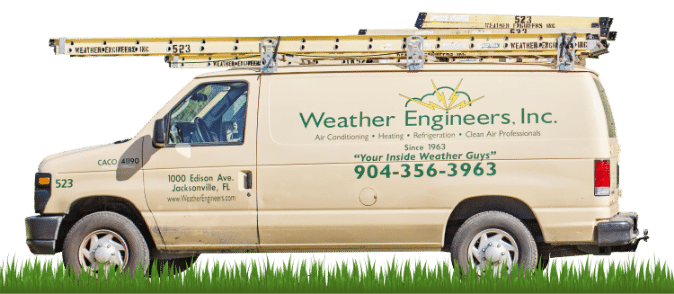Air conditioners use a whopping 6% of the electricity produced in the United States. That’s a significant chunk of energy. Unfortunately, a faulty AC unit can use even more electricity, driving up your bills.
One of the most common culprits behind a faulty AC is the condenser unit located outside your home. The condenser unit cools down the refrigerant circulating throughout your AC. The hot refrigerant absorbs heat from inside your home, and the condenser unit then releases that heat outside, leaving cool air circulating back indoors.
To stay cool in your Fleming Island home, your AC condenser unit must run smoothly. Troubleshooting common condenser unit problems can help. This guide will walk you through easy checks and fixes.
Check the Power
Before further troubleshooting, ensure your AC condenser unit receives power. The breaker box, typically located in your garage, basement, or utility closet, houses all the electrical switches for your home. Identify the breaker labeled for your AC unit-it might have the label “AC” or be specific to the room it cools (e.g., “Living Room AC”).
Look at the breaker switch for your AC unit. It should be in the “ON” position; usually, the switch is flipped upwards. If the switch is in the “OFF” position (flipped downwards), flip it to the “ON” position.
Go outside and locate the condenser unit. It often has a small on/off switch or a control panel. Ensure this switch is also turned “ON” or set to the desired cooling mode.
If you flip the breaker switch and the unit’s on/off switch to “ON,” the unit should power up. But if it doesn’t, there might be a more serious electrical issue. At this point, consult a qualified technician for heating and cooling near me.
Clean the Condenser Coils: Removing Dust for Improved Efficiency
Dirty condenser coils are a major cause of malfunctioning AC units. Dust, grime, and other built-up particles can act as insulators. They prevent the unit from releasing heat effectively.
Before cleaning, turn off the AC unit at the breaker box and the unit itself. Do this to prevent accidental electrical shock while cleaning. You’ll need a garden hose with a gentle spray nozzle attachment and a soft-bristled brush.
Attach the gentle spray nozzle to your garden hose. Turn on the water and spray the condenser coils from the top down, working your way across the fins. The key is to use a gentle spray to loosen and remove dirt without bending the delicate fins.
Avoid using high-pressure water or a stiff brush, as these can easily damage the thin metal fins. Continue spraying until all visible dirt and grime are removed. You should see water running freely from the bottom of the unit.
Clear Debris: Maintaining Airflow for Optimal Performance
Your AC condenser unit relies on proper airflow to function efficiently. Blocked airflow can significantly reduce cooling capacity. It can also put extra strain on the system.
Make it a habit to clear debris around the condenser unit at least once a month, especially during peak cooling seasons. This will prevent a buildup of leaves, twigs, or grass clippings. These outdoor debris tend to obstruct the unit.
As a general rule, keep at least a two-foot clearance around the entire condenser unit. This allows for proper air intake and exhaust. If your unit lies near bushes or hedges, trim vegetation to maintain this recommended clearance.
While clearing debris, inspect the fan and condenser fins (the thin metal plates) for obstructions. Leaves, branches, or bird nests can sometimes get lodged in these areas, further restricting airflow. Carefully remove any debris found.
Inspect the Air Filter
Think of your air filter as the lungs of your AC system. A clogged filter restricts airflow, making the condenser unit work harder to cool the same amount of air. It not only reduces efficiency and drives up your heating costs, but it can also lead to the condenser overheating.
Locate your air filter – typically found inside your home near the return air vent. Hold it up to light. If you can’t see the light passing through easily, get an ac repair free estimate from a technician.
Check the Thermostat Settings
Your thermostat instructs the condenser unit when to turn on and off. A faulty thermostat or incorrect settings can lead to inefficient cooling. Ensure your thermostat is on “cool” mode to check the settings.
The desired temperature should be lower than the current room temperature. If your thermostat seems unresponsive or shows signs of damage, it needs an AC replacement or repair. A programmable thermostat model is ideal for better control and energy savings.
Look for Leaks
Leaks in the refrigerant lines that connect your condenser unit to the indoor unit can significantly impact cooling performance. Refrigerant acts like a carrier for heat. A leak means less refrigerant is available to cool your home.
Inspect the refrigerant lines for signs of damage or air conditioner leaking. Look for areas where the line might be cracked, frayed, or discolored. Since you won’t be able to see the refrigerant itself, focus on spotting any hissing sounds or oily residue around the lines.
Listen for Unusual Noises
Your AC condenser unit should run smoothly with a gentle hum. Unusual noises might indicate internal problems that need attention. Stand outside near the condenser unit and listen for loud grinding, clanging, or screeching sounds.
It’s best to turn off the system if you hear any concerning noises. You should also call professional AC companies for diagnosis and repair. Ignoring these sounds could cause more serious and expensive problems.
AC Repair Near Me: Schedule Professional AC Condenser Unit Service Today
Follow these troubleshooting tips for a cool and comfortable Fleming Island summer. But if your AC condenser unit seems to have a more serious problem, call a qualified Fleming Island AC repair technician. A timely repair can prevent a small issue from snowballing into a costly breakdown later.
For solutions beyond these DIY fixes or to ensure your AC is ready for the season, turn to Weather Engineers. As your trusted Jacksonville HVAC company, we are here to help. So schedule a service with us today.




